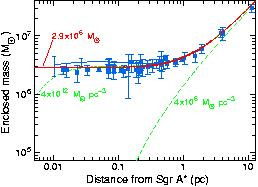


3.4 Our Galaxy: MBH
 (2.9 ± 0.4) x 106
M
(2.9 ± 0.4) x 106
M
Our Galaxy has long been known to contain the exceedingly compact radio
source Sgr A*. Interferometry gives its diameter as 63
rs by less
than 17 rs, where rs = 0.06 AU = 8.6
x 1011 cm is the
Schwarzschild radius of a 2.9 x 106
M BH. It is
easy to be
impressed by the small size. But as an AGN, Sgr A* is feeble: its radio
luminosity is only 1034 erg s-1
BH. It is
easy to be
impressed by the small size. But as an AGN, Sgr A* is feeble: its radio
luminosity is only 1034 erg s-1
 100.4
L
100.4
L . The
infrared and high-energy luminosities are higher, but there is no compelling
need for a BH on energetic grounds. To find out whether the Galaxy contains a
BH, we need dynamical evidence.
. The
infrared and high-energy luminosities are higher, but there is no compelling
need for a BH on energetic grounds. To find out whether the Galaxy contains a
BH, we need dynamical evidence.
Getting it has not been easy. Our Galactic disk, which we see in the sky
as the Milky Way, contains enough dust to block all but ~ 10-14 of
the optical light from the Galactic center. Measurements of the region around
Sgr A* had to await the development of infrared detectors. Much of the infrared
radiation is in turn absorbed by the Earth's atmosphere, but there is a useful
transmission window at 2.2 µm wavelength. Here the
extinction toward the
Galactic center is a factor of ~ 20. This is large but manageable.
Early infrared measurements showed a rotation velocity of V
 100 km
s-1 and a small rise in velocity dispersion to ~ 120 km
s-1 at
the center. These were best fit with a BH of mass
MBH ~ 106
M
100 km
s-1 and a small rise in velocity dispersion to ~ 120 km
s-1 at
the center. These were best fit with a BH of mass
MBH ~ 106
M ,
but the evidence was not very strong. Since then, a series of spectacular
technical advances have made it possible to probe closer and closer to the
center. As a result, the strongest case for a BH in any galaxy is now our own.
,
but the evidence was not very strong. Since then, a series of spectacular
technical advances have made it possible to probe closer and closer to the
center. As a result, the strongest case for a BH in any galaxy is now our own.

|
Figure 4. Images of the star cluster surrounding Sgr A* (green cross) at the epochs indicated. The arrows in the left frame show approximately where the stars have moved in the right frame. Star S1 has a total proper motion of ~ 1600 km s-1. [This figure is updated from Eckart & Genzel 1997, M.N.R.A.S., 284, 576 and was kindly provided by A. Eckart.] |
Most remarkably, two independent groups led by Reinhard Genzel and Andrea
Ghez have used speckle imaging to measure proper motions - the velocity
components perpendicular to the line of sight - in a cluster of stars at radii
r  0".5
0".5
 0.02 pc from Sgr A*
(Figure 4). When combined
with complementary measurements at larger radii, the result is that the
one-dimensional velocity dispersion increases smoothly to 420 ± 60 km
s-1 at r
0.02 pc from Sgr A*
(Figure 4). When combined
with complementary measurements at larger radii, the result is that the
one-dimensional velocity dispersion increases smoothly to 420 ± 60 km
s-1 at r  0.01 pc. Stars at this radius revolve around the
Galactic center in a human lifetime! The mass M(r) inside radius
r is shown in
Figure 5. Outside a few pc, the mass
distribution is dominated by stars, but
as r -> 0, M(r) flattens to a constant,
MBH = (2.9 ± 0.4) x 106
M
0.01 pc. Stars at this radius revolve around the
Galactic center in a human lifetime! The mass M(r) inside radius
r is shown in
Figure 5. Outside a few pc, the mass
distribution is dominated by stars, but
as r -> 0, M(r) flattens to a constant,
MBH = (2.9 ± 0.4) x 106
M . Velocity
anisotropy is not an uncertainty; it
is measured directly and found to be small. The largest dark cluster that is
consistent with these data would have a central density of 4 x 1012
M
. Velocity
anisotropy is not an uncertainty; it
is measured directly and found to be small. The largest dark cluster that is
consistent with these data would have a central density of 4 x 1012
M pc-3. This is inconsistent with astrophysical
constraints (Section 5).
Therefore, if the dark object is not a BH, the alternative would have to be
comparably exotic. It is prudent to note that rigorous proof of a BH requires
that we spatially resolve relativistic velocities near the Schwarzschild
radius.
This is not yet feasible. But the case for a BH in our own Galaxy is now very
compelling.
pc-3. This is inconsistent with astrophysical
constraints (Section 5).
Therefore, if the dark object is not a BH, the alternative would have to be
comparably exotic. It is prudent to note that rigorous proof of a BH requires
that we spatially resolve relativistic velocities near the Schwarzschild
radius.
This is not yet feasible. But the case for a BH in our own Galaxy is now very
compelling.

|
Figure 5. Mass distribution implied by
proper motion and radial velocity
measurements (blue points and curve). Long dashes (green) show the mass
distribution of stars if the infrared mass-to-light ratio is 2. The red
curve represents the stars plus a point mass MBH = 2.9
x 106
M |